This is a post war tester for electron-tubes. There are of course war-time
testers, but I did not obtain one, yet.
As the goal of the hobby is to maintain
radio's, I don't have any problem to use younger tools to reach this goal.
My
screwdrivers and soldering iron are also post war time!
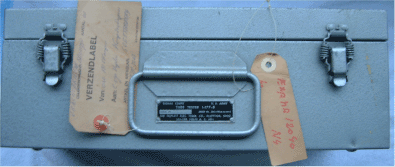 |
It
comes in a handy metal case. I left the labels on it, that where attached
when I obtained it. The labels state the original owner: the Dutch army.
It was probably send to a warehouse for taking it out of service and for
selling to some surplus-trader, eventually. |
 |
This
is it's identification tag. The serial number is 1807, the contract or
order number mentions the year 1952. Ever heard of Bluffton, Ohio? I
asked this question on saturday, September 13, 2003 when I made this
web-page. On Friday, August 24, 2007 I received an answer to that question
from Darrell E. Groman. Follow
this link for
information about The Triplett Electrical Instrument Company, and, of course:
Bluffton, Ohio. Thanks, Darrell! |
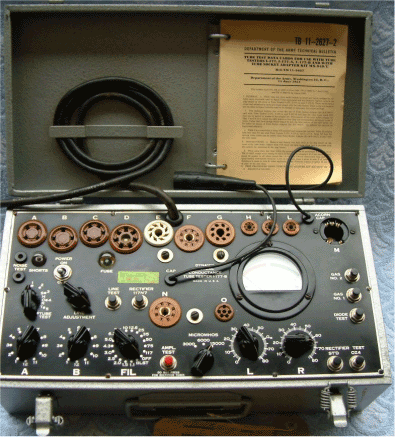 |
In
the lid the power cord is stored. A booklet is also there in which the
settings for various tubes can be found. The two short wires with the
rubber caps are for tubes that have a top-connection. The sockets can
receive tubes, going back to the 1930's!
The booklet is dated june 11, 1951. In fact, it is only 49 days older than I
am!
The green sticker indicates when the set is due for calibration again.
The date on it is March, 14, 1978. This indicates the time this set has
been in service, or in stock and when it was disposed of.
The socket, marked "E" has a double function. It also
connects the MX-949 extension box, through which a large number of other,
more modern tubes can be tested. You will see this later. |
 |
The
meter in close-up. Used to calibrate the equipment to the line voltage and
measure the amplification of the tube. Another visual indicator is a small
neon-bulb, mounted under socket A. This is used to indicate short-circuits
between the elements inside the tubes. |
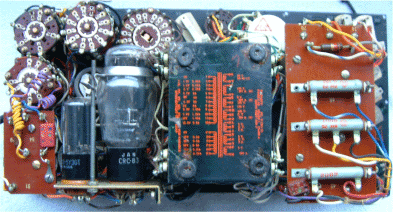 |
The
interior shows robust construction. The black box is the transformer. The
two valves are rectifiers. No printed circuit boards in those days! All
components are wired by hand..... |
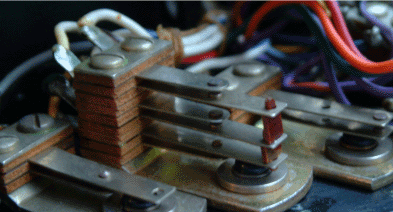 |
....
and made to last a life time. |
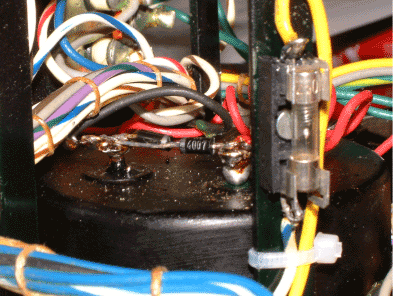
Want to know the details of this modification?
Click this
link for a diagram! |
As
I was searching the web for data of this fine piece of equipment I was
lucky to find the website of Nolan Lee. Unfortunately, Nolan is no longer
with us. A copy of his site is now hosted by Steve Johnson and can be found
on:
http://www.antiqueairwaves.com/nlee/ This man really knew his tube testers! We came into correspondence and
he coached me through some important modifications that you can see on
this picture.
Nolan was a very helpful guy who had collected a lot of information as
well as tube charts that are still available for downloading.
So now I have a good working tester and data on a lot more tubes than
there are in the original booklet of 1951. |
| |
|
| The
MX-949-A/U extension box |
|
| The
purpose of this box is to extend the number of sockets of the I-177-B. A
cable connects to socket E on the tester. A large number of sockets are
available. By using a number of patch cables and -sockets every pin of the
tube to be tested can be connected to its proper element. |
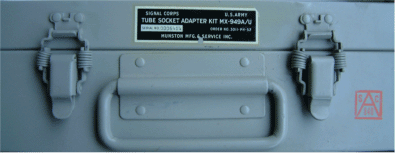 |
|
 |
This
box is made by Munston. Year of manufacturing is 1952. They made at least
6414 pieces... |
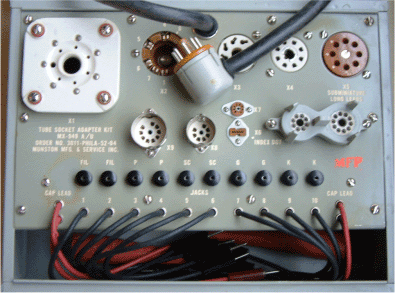 |
In
the middle the most modern sockets: look at X7 and X8!
Under you see the patch cables and -sockets. In case of a Noval-tube,
you can connect for example pins 4 and 5 to sockets "F" and
"F", which means "filament". "P" means
"Plate", "G" means "Gate" and "K"
means "Kathode". |
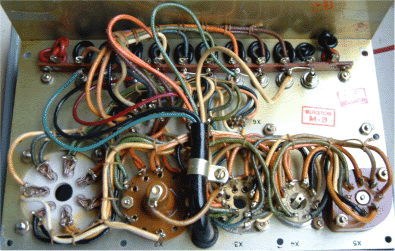 |
The
inside shows the same ruggedness. Wiring is treated with a sealing
compound that must prevent moisture to damage the equipment.
That's the stuff that has this distinctive smell, that every surplus
radio hobbyist loves. |
|
|
| |
|
| |
|
|
|
|
|
|
|
|
|










